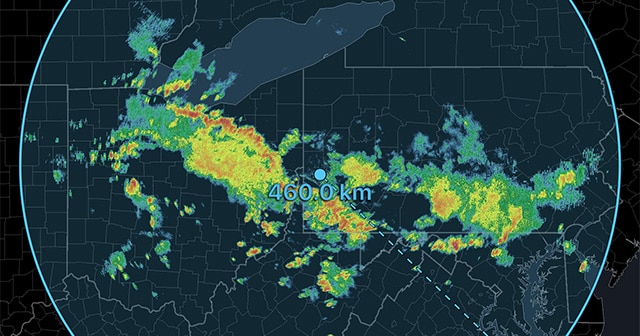

The height of the radar beam itself also presents a challenge. Vast swaths of land in Oregon, Nevada, and Utah have little useful radar coverage at the lower levels of the atmosphere due to the region’s rough terrain, which can make it more difficult to spot hazards in these areas. Mountains are a significant barrier to radar use in the western United States. Like any technology, there are limitations. Bright colors all moving in one direction are a sign of damaging straight-line winds like you’d see in a squall line. You can spot rotation and a possible tornado in a thunderstorm by looking for strong winds blowing in different directions right next to each other. Stronger winds usually equate to brighter colors on the radar imagery. Red shows winds blowing away from the radar, and green shows winds blowing toward it. Velocity imagery is almost always displayed with red and green colors. It becomes apparent that there’s a tornado on the ground once you flip over to velocity imagery and look at the wind swirling within the storm. Nothing appears too suspicious, right? But looking at the rain alone is deceiving. The following radar image shows precipitation within the line of thunderstorms while the EF-2 tornado was in progress. The tornado that hit Greensboro, North Carolina, in April 2018 is a great example of why it’s so important to look at the wind within a storm. This technological advance has saved countless lives over the past couple of decades. Velocity imagery is critically important, because it tells you what’s going on inside of a storm, something you wouldn’t inherently know just by looking at the precipitation. By using the Doppler effect to measure how fast and in which direction rain, hail, and snow are moving, it can accurately tell us the wind speed and direction of a storm. In the 1990s, weather-radar technology developed enough to let us see the winds within a thunderstorm. (EF refers to the Enhanced Fujita scale, which rates tornado damage from 0 to 5.) Know What’s Going on Inside a Storm This particular thunderstorm produced an EF-4 tornado with estimated winds of 180 miles per hour. The rotating updraft allows the storm to produce large hail, high wind gusts, and strong tornadoes. The image above shows a classic supercell-a thunderstorm with a rotating updraft-in Alabama on March 3. A radar image of a supercell thunderstorm producing a large tornado in Alabama on Ma(NOAA/Gibson Ridge)Ī storm that looks like a fishhook is particularly concerning. A line of heavy precipitation moving in unison is a sign of a squall line that could pack gusty winds.

Radarscope free Patch#
A patch of dark red moving toward your location means there’s a thunderstorm on the way. However, just looking at the precipitation alone won’t tell you everything you need to know about a storm. Most color scales are simple rainbows, and warmer colors indicate heavier precipitation. Just about everyone who’s ever used a weather app or watched a weather forecast on television knows the basics about spotting precipitation on weather-radar imagery.
Radarscope free how to#
How to Read Weather Radar: 4 Useful Tips Look at More Than Just Precipitation The best way to stay safe from dangerous weather, whether you’re hiking or hanging out at home, is to invest in a good radar app for your phone and learn how to read what it’s telling you.
Radarscope free plus#
The shape of the beam, which resembles a plus sign if you look at it head-on, also allows the radar to detect the size and shape of the objects it detects, which is useful in spotting hail and tornado debris.
Radarscope free software#
Software measures the strength of returning radiation and how long it took to bounce back in order to determine the location and intensity of the precipitation. Some of the radiation reflects off objects in the atmosphere-rain, hail, snow, you name it-and returns to the radar.

Weather radar works by sending out two perpendicular beams of microwave radiation into the atmosphere. But bad storms don’t take us by surprise as much as they once did, thanks to weather radar. It also means we have to be prepared for the threat of tornadoes, large hail, damaging winds, and floods. Spring is here, and that means warmer temperatures.


 0 kommentar(er)
0 kommentar(er)
